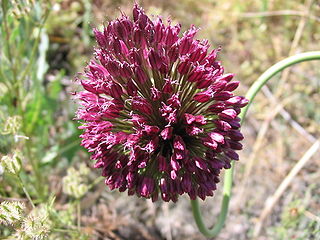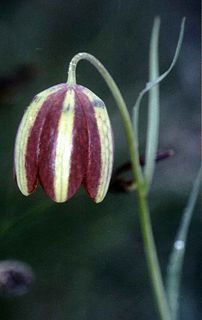
Oregano is a species of flowering plant in the mint family Lamiaceae. It was native to the Mediterranean region, but widely naturalised elsewhere in the temperate Northern Hemisphere.

Colchicum is a genus of perennial flowering plants containing around 160 species which grow from bulb-like corms. It is a member of the botanical family Colchicaceae, and is native to West Asia, Europe, parts of the Mediterranean coast, down the East African coast to South Africa and the Western Cape. In this genus, the ovary of the flower is underground. As a consequence, the styles are extremely long in proportion, often more than 10 cm (4 in). All species in the genus are toxic.

The genus Ophrys is a large group of orchids from the alliance Orchis in the subtribe Orchidinae. They are widespread across much of Europe, North Africa, Caucasus, the Canary Islands, and the Middle East as far east as Turkmenistan.

The peony or paeony is a flowering plant in the genus Paeonia, the only genus in the family Paeoniaceae. Peonies are native to Asia, Europe and Western North America. Scientists differ on the number of species that can be distinguished, ranging from 25 to 40, although the current consensus is 33 known species. The relationships between the species need to be further clarified.

Cyclamen is a genus of 23 species of perennial flowering plants in the family Primulaceae. Cyclamen species are native to Europe and the Mediterranean Basin east to the Caucasus and Iran, with one species in Somalia. They grow from tubers and are valued for their flowers with upswept petals and variably patterned leaves.

Colchicum autumnale, commonly known as autumn crocus, meadow saffron, or naked ladies, is a toxic autumn-blooming flowering plant that resembles the true crocuses, but is a member of the plant family Colchicaceae, unlike the true crocuses, which belong to the family Iridaceae. The name "naked ladies" is because the flowers emerge from the ground long before the leaves appear. Despite the vernacular name of "meadow saffron", this plant is not the source of saffron, which is obtained from the saffron crocus, Crocus sativus – and that plant, too, is sometimes called "autumn crocus".

Epimedium, also known as barrenwort, bishop's hat, fairy wings, horny goat weed, or yin yang huo, is a genus of flowering plants in the family Berberidaceae. The majority of the species are endemic to China, with smaller numbers elsewhere in Asia, and a few in the Mediterranean region.

The golden samphire is a perennial coastal species, which may be found growing on salt marsh or sea cliffs across western and southern Europe and the Mediterranean.

Allium sphaerocephalon is a plant species in the Amaryllis family known as round-headed leek, round-headed garlic, ball-head onion, and other variations on these names. Drumstick allium is another common name applied to this species. Some publications use the alternate spelling Allium sphaerocephalum. It is a bulbous herbaceous perennial plant.

Crocus sativus, commonly known as saffron crocus, or autumn crocus, is a species of flowering plant of the Crocus genus in the iris family Iridaceae. It is best known for producing the spice saffron from the filaments that grow inside the flower. The term "autumn crocus" is also used for species in the Colchicum genus, which strongly resemble crocuses. However, crocuses have 3 stamens and 3 styles, while colchicums have 6 stamens and 1 style, and belong to a different family, Colchicaceae. Colchicums are also toxic.

Ballota nigra, black horehound, is a perennial herb of the family Lamiaceae. It is native to the Mediterranean region and to central Asia and it can be found throughout Europe. It is also naturalized in Argentina, New Zealand, and the Eastern United States. It blooms in the Northern Hemisphere from May to August.

Ophrys sphegodes, commonly known as the early spider-orchid, is a species of sexually-deceptive orchid native to Europe and the Middle East. It is a very varied species with many subspecies recognised.

Colchicum macrophyllum has large, funnel-shaped flowers in the fall with much tessellation throughout the bloom. The colour is rosy-purple and white. The leaves that it produces in the spring are large, up to 16" (40 cm) long, among the largest of all colchicum species.
Colchicum lingulatum is a species of flowering plant in the Colchicaceae family. It is native to north-western Turkey and to Greece.
Colchicum parnassicum is a plant species endemic to the Sterea Ellada region of central Greece. It is closely related to Colchicum autumnale, mainly being different in having shorter flowers. The blooms are produced in fall and have a medium pink colour. The flowers hold up well in fall weather. This species, if cultivated in cold climates, it will do better in a sunny, sheltered location.
Colchicum zahnii is a member of the flowering plant family Colchicaceae that is native to southern Greece. It blooms in mid-fall from rhizomatous corms. The flowers can be variable colored, being a pale purple-pink to white and are often held wide open. The leaves are produced at flowering time and usually number 2 to 3. This species is similar to Colchicum boissieri in that the corms grow into large patches, rather than tight clumps like Colchicum speciosum or Colchicum autumnale.

Colchicum bulbocodium, the spring meadow saffron, is a species of alpine bulbous plant native to mountain ranges across Europe from the Pyrenees to the Caucasus.

Fritillaria messanensis is a European species of flowering plant in the lily family Liliaceae, native to southeastern Europe: Italy, Greece, Albania, former Yugoslavia.

Colchicum szovitsii subsp. brachyphyllum, synonym Colchicum brachyphyllum, is a subspecies of Colchicum szovitsii.
















